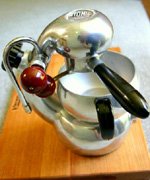
Some of the Thos Cara Atomics were fitted with a pressure gauge and marketed as a "de luxe" model - probably the only time in history that "de luxe" denotes something less desirable than "standard"! If you have one of these machines, here are the instructions:
"For best results in frothing milk... wait until gauge reaches 3 kg. Do not overheat machine or plastic dial cover will melt. The plastic piece is replaceable (really?). If gauge indicator recedes to zero while machine is in operation, turn off the heat, this indicates that the water has been completely depleted."









